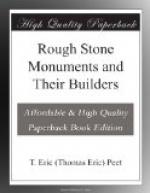At the same time it must not be forgotten that Sir Arthur Evans has spoken in favour of a date in the first half of the third century B.C. He believes that the great circles are religious monuments which in form developed out of the round barrows, and that Stonehenge is therefore much later than some at least of the round barrows around it. That it is earlier than others is clear from the occurrence in some of them of chips from the sarsen stones. He therefore places its building late in the round barrow period, and sees confirmation of this in the fact that the round barrows which surround the monument are not grouped in regular fashion around it, as they should have been had they been later in date.
Many attempts have been made to date the monuments by means of astronomy. All these start from the assumption that it was erected in connection with the worship of the sun, or at least in order to take certain observations with regard to the sun. Sir Norman Lockyer noticed that the avenue at Stonehenge pointed approximately to the spot where the sun rises at the midsummer solstice, and therefore thought that Stonehenge was erected to observe this midsummer rising. If he could find the exact direction of the avenue he would know where the sun rose at midsummer in the year when the circle was built. From this he could easily fix the date, for, owing to the precession of the equinoxes, the point of the midsummer rising is continually altering, and the position for any year being known the date of that year can be found astronomically. But how was the precise direction of this very irregular avenue to be fixed? The line from the altar stone to the Friar’s Heel, which is popularly supposed to point to the midsummer rising, has certainly never done so in the last ten thousand years, and therefore could not be used as the direction of the avenue. Eventually Sir Norman decided to use a line from the centre of the circle to a modern benchmark on Sidbury Hill, eight miles north-east of Stonehenge. On this line the sun rose in 1680 B.C. with a possible error of two hundred years each way: this Sir Norman takes to be the date of Stonehenge.




